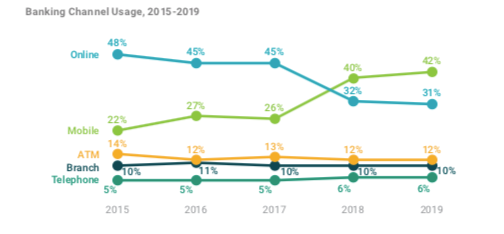
New study: Challenger banks overtake traditional banks in customer satisfaction, in 4 charts
via Tearsheet
Challenger banks have leapfrogged to the forefront in overall customer satisfaction, according to a new study from FIS.
The 2019 FIS Performance Against Customer Expectations (PACE) surveyed almost 1800 US consumers.
Customers increasingly like challenger banks
63 percent of direct bank customers report being “extremely satisfied”, compared to 52 percent of credit union customers and just 19 percent of customers of the top 50 global banks.

Consumer preference of DTC banks is part of a larger trend that sees challenger banks rising in overall satisfaction metrics over last year’s study. Direct banks scored 3.52 on a 4 point scale, rising 7 percent over 2018, while credit unions, regional banks, and top 50 global banks all saw their overall satisfaction numbers drop year over year.
Digital isn’t a trend, it’s a fact
73 percent of all consumer interactions with banks in the US are done digitally. While adoption has plateaued, digital banking is table stakes now. Customers are beginning to expect their banks to deliver the same type of experiences they consume with other service providers.
According to the study, millennials prefer to do much of their banking digitally. Nearly two-thirds (65 percent) of younger millennials (between ages of 18 and 26) reported that they have not used any branches at all in the prior month.

“The battleground for winning and keeping today’s banking consumers is in the front lines of customer experience,” said Bruce Lowthers, co-chief operating officer, FIS.
“While security and trustworthiness continue to be critical attributes, more consumers are choosing their banking providers on the basis of a convenient, frictionless digital experience. For banks and credit unions of all sizes, these survey results reinforce the importance of modernizing every touch point of their customer journeys.”
Younger customers gravitate toward fintechs
Fintech firms have come a long way in the minds of customers when it comes to security and safety. Only 45 percent of young millennials trust banks more than fintech companies. It’s not just trust, either, that enables younger customers to defect to newer offerings. People go outside their banks because it’s frequently easier to get financial stuff done at a technology-driven company.

Young millennials trust referrals more than other demographics

The best way to get to the younger millennial demographic is to find ways to influence their peers. More than any other age group, young millennials are susceptible to recommendations. 75 percent of this age group were referred to their primary bank. Because this demographic also tends to use fintech substitutes, it’s important for financial providers that want to reach them to reach their friends and families, too.
As more young millennials open accounts, the study recommends encouraging and incentivizing them to share their banking experience within their social network. But, there’s a huge caveat — these customers don’t give out recommendations lightly. Don’t expect young millennials to recommend a bank if its digital convenience and intuitive design isn’t competitive with other offerings.





